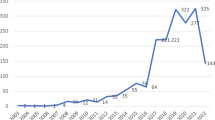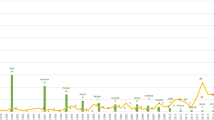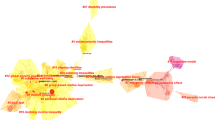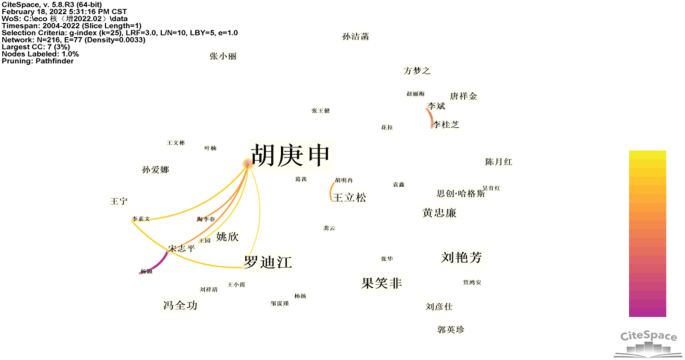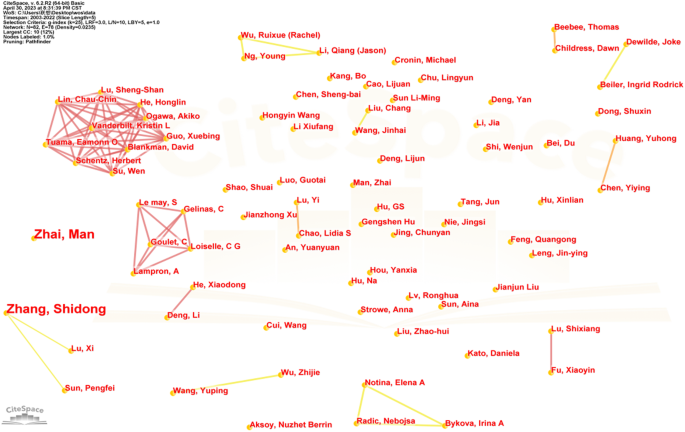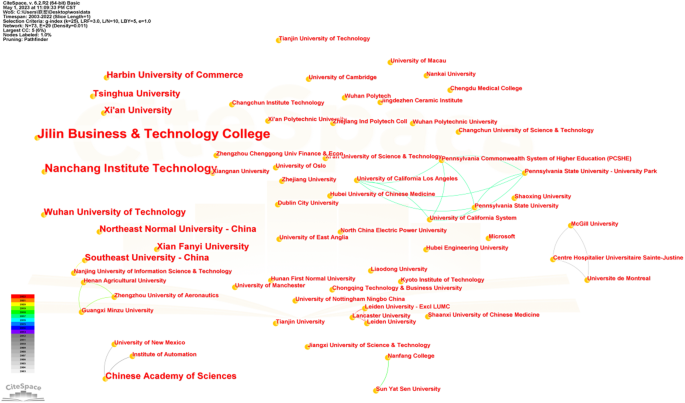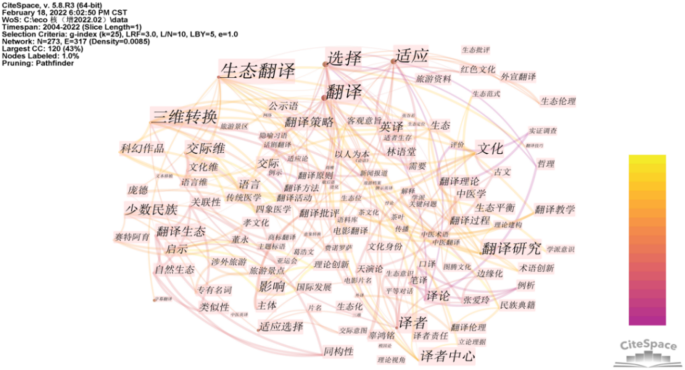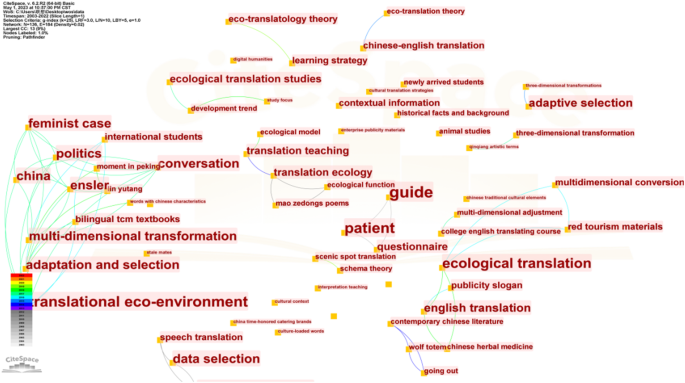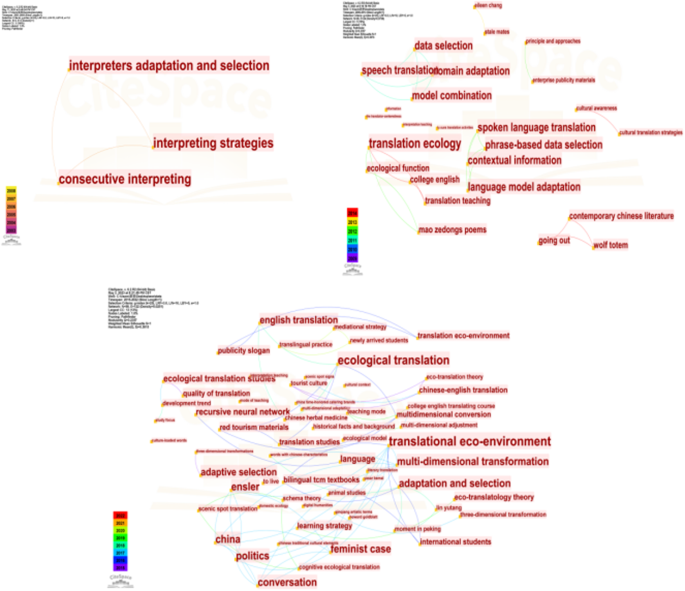Abstract
The present study endeavors to unveil the progression of research subjects within the realm of China’s ecotranslatology studies through the examination of journal papers in the databases of China National Knowledge Infrastructure (CNKI) and Web of Science (WOS) from 2001 to 2022, utilizing CiteSpace software for mapping and analyzing cooccurrences among authors, institutions, and keywords. The findings indicate that within ecotranslatology studies, a prominent theory-founding research group represented by Hu Gengshen has been established, yet no comparable clusters have been identified among scholars engaged in debate or applied studies. Additionally, a lack of effective cooperation and diversity among research entities as well as inadequate responses to questions and concerns have been observed. Furthermore, research focuses have undergone a shift, progressing from theory founding studies (2001–2008) to confirmation and verification studies (2009–2014) and finally to revision and applied studies (since 2015). Additionally, research topics have transitioned from grand, abstract theoretical foundations to subtle, specific theory revisions and applied translation studies, yet a dearth of quantitative research, comparative studies, or field studies have been conducted. In conclusion, it is suggested that future ecotranslatology studies should be more responsive to doubts and questions, cultivate diverse research entities, and place greater emphasis on field investigation within qualitative research.
Similar content being viewed by others
Introduction
Western translation studies in the 20th century underwent successive shifts in perspective, including linguistic turns, cultural turns, and sociological turns, resulting in a broadening of research angles from a mere linguistic perspective to a more comprehensive cultural and social lens. In the east, ecotranslatology, which emerged at the beginning of the 21st century, has further expanded the scope of research to an ecological perspective. This has led to an enhancement in the breadth, depth, and scope of research in three dimensions. Its theoretical system not only incorporates Chinese and Western ecological thought but also conducts an all-encompassing ecological paradigm exploration of translation phenomena, translation processes, and translation essence. At present, “the study of ecotranslatology has gone through 21 years of self-creation, self-validation, self-development, and self-improvement … has formed a unique ecological paradigm study, releasing its full explanatory power of understanding and application” (Hu & Luo, 2021, p. 11). The number of research articles and research hotspots have been increasing yearly; however, “there are still many things to be considered” (Wu & Zou, 2021, p. 5). Therefore, it is necessary to systematically and reasonably review the research on ecological translation in the past 21 years.
To comprehensively understand the research landscape, academic groups, research hotspots, and the differences between domestic and international research in ecotranslatology over the past 21 years, this paper visualizes and analyses the knowledge units of ecotranslatology research at home and abroad via CiteSpace, a scientometric analysis tool, in an attempt to sort out the research network in this discipline, track research trends and uncover research frontiers, with a view to providing directional guidance for future ecotranslatology research.
Literature review
As cultural consciousness continues to rise, Oriental translation studies are no longer content with being mere followers or subordinates of Western translation studies. Gradually, Chinese translation studies have progressed from borrowing, learning, and imitating from the West to an attempt at the domestic substitution of translation theories. It has resulted in a shift that has “transformed from followers of foreign translation studies to peers and is innovating their own translation systems and academic discourses (Fang, 2021, p. 30)”. The creation of the system of ecotranslatology demonstrates its academic, cultural, historical, and social values, breaking free from the limitations of translation research in terms of language and culture (Luo, 2021, p. 60). Undoubtedly, it is the most influential theory in the effort to construct the discourse system of Chinese translation studies.
Tracing the origins of ecotranslatology studies reveals that they can be attributed to the paper entitled “An introduction of translation as adaptation and selection theory” presented by Geng Shen Hu at an international academic conference in Hong Kong in 2001, as well as his monograph “Translation as adaptation and selection theory” that was published in 2004. As the field continues to evolve, theoretical research in ecotranslatology has centered on key concepts and terminology (Zeng & Huang, 2018; Wei & Liu, 2022), such as translation as adaptation and selection theory (Hu, 2004), translator-centeredness (Hu, 2011; Luo, 2019, 2020; Yue, 2019), translational eco-environment (Wei, 2013; Fang, 2020), ecological paradigm (Hu, 2019) and green translation (Feng & Zhang, 2014). These studies have established the relationship between conceptual boundaries and the theoretical logical framework, defined the scope of academic research, and improved the precision and scientific nature of ecotranslatology studies. In this paper, terms such as adaptation, selection, and ecotranslatology were chosen as literature search terms due to their significance and universality.
However, ecotranslatology studies do not go without challenges and criticisms. Wang (2011) posited that the central concept of ecotranslatology and the formation of its system are derived from an understanding of the tripartite relationship concerning the definition of translation and thus still require ongoing revision. Leng (2011) has raised concerns that Darwin’s theory of adaptive selection is not capable of logically deriving “translator-centeredness” and that translators must continually adapt to their ecological environment. Moreover, Meng (2019) and Fang (2020) offered insightful reflections and discussions on the core concept of ecotranslatology.
Despite these challenges, ecotranslatology has been applied to various areas of study, such as literary translation (Tong & Huo, 2010; Liu & Wang, 2012), subtitle translation (Xiu & Jiang, 2018), cultural translation (Sun & Han, 2021), and political text translation (Yuan, 2021), thereby affirming its interpretive and applicative scope. However, there may be issues of “imposed interpretation” (Wei & Liu, 2022), “theoretical affiliation” (He, 2022), and theoretical “impropriety” in the aforementioned studies (Mu and Yang, 2020), among others. As it stands, current research in ecotranslatology encompasses theoretical establishment, questioning debates, and practical application studies.
The past 21 years have seen significant growth in ecotranslatology studies, yet exciting progress has received a limited number of scholarly reviews. Sichon (2011) reviewed the major achievements of ecotranslatology during the period of 2001–2011 in terms of journal papers, dissertations, national projects, academic seminars, and overseas publications. In addition to summarizing the “internationalization” of ecotranslatology studies, including the international association and symposium on it, he also suggested workable directions for it (Shichon, 2013). Huang & Wang (2021) reviewed the growth trajectory of ecotranslatology research in the past 20 years, sorted out the literature on it from the perspectives of theoretical construction, theocratic enrichment and transformation, responded to ecotranslatology reviews, and foresaw the future trends of this field.
However, these literature reviews mainly adopt qualitative research methods and rely on the authors’ own research framework to organize the literature, which is comprehensive and profound, but it is difficult to avoid the constraints of subjectivity. On the other hand, the quantitative literature review on ecotranslatology studies is evidently inadequate (Chen, 2017; Teng & Zhou, 2019; Wang et al. 2019). These studies depict the changes and characteristics of the overall literature publication but do not have a thorough understanding of the stage characteristics and the evolution of the disciplinary history and do not sufficiently explore, describe, and interpret the deeper information implied by the data.
This paper employs literary visualization software to objectively depict the progression of ecotranslatology, gain insight into vital scholarly groups of ecotranslatology and their salient perspectives, visually depict the phase characteristics and metamorphosis of ecotranslatology’s focal points, and clarify the areas of deficiency and lacunae within its examination, which holds considerable referential value and pragmatic significance for ameliorating translation theory with Chinese characteristics and augmenting the scholarly prestige of ecotranslatology.
Research methodology
Literature retrieval
The data for this manuscript were procured from scholarly periodicals on the subject of ecotranslatology within Chinese and international databases. International studies were selected from the Web of Science Core Collection (WOS) as the data source. The authors selected the Science Citation Index Expanded (SCI-Expanded), Social Sciences Citation Index (SSCI), Arts & Humanities Citation Index (A&HCI), Conference Proceedings Citation Index - Science (CPCI-S), and Conference Proceedings Citation Index - Social Sciences & Humanities (CPCI-SSH). A total of five databases were searched for topics. The search formula was TS = (“eco-translation” OR “ecotranslatology” OR “translation ecology” OR “ecological translation”) and TS = (“adaptation and selection AND translation”). The type of literature was set to “thesis”, “conference paper” and “book review”. The time frame for the search was 1 January 2001, through 1 January 2022. After reading and filtering each of the search results individually, 69 articles—the latest of which was published in January 2022 and the earliest in 2003—were obtained after deduplication and the removal of pointless documents.
The database of the China National Knowledge Infrastructure (CNKI) provided the source for domestic research on ecotranslatology. In accordance with a prior literature review of ecotranslatology, “adaptation” and “selection” have been acknowledged as the seminal keywords of this inquiry. Consequently, in this paper, “adaptation” and “selection” were selected as the literature search terms, and an “advanced search mode” was employed utilizing “AND” and “OR” Boolean logic searches with the subject terms “adaptation”, “selection”, “translation” and “ecotranslatology”, respectively.
Given the temporal limitation, this paper encompasses the inception of the ecotranslatology study until the composition of the paper; the inception date for the literature search was established as 1 January 2001, and the conclusion date as 1 February 2022. The specific procedures of the literature search were as follows: first, utilizing advanced search mode with “adaptation” and “selection” and subsequently conducting a secondary search with “translation” as the keyword from the prior results; second, proceeding with advanced search mode again with “ecotranslatology” as the keyword; third, eliminating nonresearch literature such as conference announcements, appointments, columns, research updates, catalogs, and book reviews; and (4) utilizing CiteSpace to convert the format of the two searches into WOS format for deduplication and ultimately obtaining 2721 valid documents.
Stage division
In this paper, weighed as necessary is a better clarification of the advancement of ecotranslatology study in China and the shifts in the primary focus of academic discourse. The abovementioned 2721 valid documents were divided into stages and designated the “total research literature database”. Furthermore, based on the classification of academic journals’ literature sources in CNKI, 217 core journals and papers in the Chinese Social Sciences Citation Index (CSSCI) were filtered through a literature search and designated the “core literature database”. This served as the primary database for this study, and subsequent data analysis was predicated upon this database.
This manuscript computed the number of articles published in the two literature bases by year and produced a yearwise distribution of the general literature volume of ecotranslatology studies (Fig. 1) and a yearwise distribution of core ecotranslatology literature (Fig. 2).
Figures 1 and 2 reveal that the development of ecotranslatology research has progressed through three stages, and its literature volume has exhibited a trend of balanced expansion. The first stage is the theoretical formative period from 2001 to 2008, during which ecotranslatology is still in the nascent stage of theoretical establishment, from the original “translation as adaptation and selection theory” to continuous elaboration and augmentation, and the overall number of studies in this stage is relatively diminutive. The second stage is the theoretical development period from 2009 to 2014, and the volume of literature displays a trend of expeditious growth year by year, with the total volume and core literature peaking at 292 in 2014. The third stage is from 2015 to 2022, with the total volume of literature fluctuating at approximately 260 articles per year, while the volume of core literature does not exceed 20 articles in all years except 2021. In this paper, we dynamically map the research characteristics and hotspots of ecotranslatology in three stages, divided by these time periods.
For a discussion of the literature published on international ecotranslatology-related research, the data from the 69 valid publications listed above were subjected to a visual analysis in which the year and volume of publication were retraced, and the following line graphs were plotted, as shown in Fig. 3.
The annual number of articles published in international ecotranslatology research from 2001 to 2022 is shown in Fig. 3, which shows an overall upward trend in the number of articles published in this field, from one article in 2001 to 69 articles in 2022. The growth trend can be divided into three periods: the initial period (2001–2008), with a slow publication rate; the rapid growth period (2009–2014), with a slight and continuous upward trend; and the steady growth period (2015–2022), with a rapid increase in the number of publications, reaching its highest value in 2017. When contrasting this trend with that of Chinese ecotranslatology research, it may appear that the international tendency of ecotranslatology is essentially the same as the local trend in China, but the overall global volume of publications is smaller and the peak of publications occurs later than Chinese ecotranslatology studies, indicating that the influence and dissemination power of international ecotranslatology research are weaker and the progression in the international academic community is lagging.
Research tools
This paper employs CiteSpace, an application developed by Professor Chen. C.M., (2006, Drexel University, USA), to conduct a literature review on ecotranslatology. The software, which is a tool for literature analysis based on informatics, serves to reveal emerging trends and advancements within the discipline. It affords a more rationalized research foundation and data support for ecotranslatology research reviews and enables the scientific and efficient extraction of hidden knowledge embedded within the literature, thereby advancing the innovative development of the field of ecotranslatology studies.
This paper utilizes CiteSpace to convert ecological translation literature data sourced from CNKI into WOS format and subsequently undertakes visual analysis. The steps of the process are as follows: (1) Import the converted data into CiteSpace V, 5.8. R3 and establish a project; (2) generate corresponding scientific knowledge maps by modifying parameters such as Time Slicing, Years Per Slice, Threshold, Top N, and Pruning, which enables the visualization of different node types, such as authors, keywords, and institutions, separately; (3) cluster the node types, and initially analyze the Silhouette and Modularity Q of the clustering results (usually, a Q value >0.3 and an S value >0.7 and approaching 1 indicate that the clustering effect is superior and the confidence is high), and select the most representative and credible ecological translation knowledge map for data analysis and summation.
Data analysis
The data analysis in this paper primarily relies on the mapping knowledge domain analysis of CiteSpace V, 5.8. R3 (64-bit). In Section 3, the co-occurrence relationship of notable academic groups is analyzed. “Author” is chosen as the node type, the node threshold is set to 5, and the color and size of each node (font size) are adjusted. The node size and connection density reflect the publication volume and cooperative network status of prominent scholars in ecotranslatology and culminate in the generation of the co-occurrence cooperation mapping knowledge domain of leading scholars in ecotranslatology (Fig. 3). Generally, the larger nodes in the figure symbolize scholars with more publications, which reveals their value and influence in the research field. The thicker the line between the nodes, the closer the collaborative relationship between scholars, which represents the coordinating role of scholars among the nodes and measures their ability as intermediaries.
Subsequently, the data of “article volume”, “article author” and “article issuing institution” were analyzed and summarized on the basis of visual analysis and the Python language to obtain an overview of article authors and issuing institutions (see Tables 1 and 2). The larger the node-to-frequency ratio, the more dispersed the authors and institutions are, the more diverse the researchers are, and the more varied the composition of research institutions.
This is because CiteSpace utilizes a relationship-based network visualization approach to present coword relationship networks in a clear and succinct manner (Li & Chen, 2017). The co-word relationship network in word frequency studies not only enables the analysis of hotspots, topic distributions, and disciplinary structures within a field but also allows for the measurement of keyword affinities through the number of co-occurrences. As such, in Section 4, CiteSpace’s Pathfinder Network Scaling was employed to analyze the “core literature database” by means of a co-occurrence method, resulting in the derivation of a keyword co-occurrence mapping knowledge domain (Fig. 7). The circles in the figure represent a keyword node, with the size of the node indicating the frequency of occurrence, while the lines between the nodes indicate the cooccurrence relationship, and the thickness of the lines reflects the cooccurrence intensity. Additionally, the centrality of the nodes is reflected in the thickness of the purple highlighted outer ring of the nodes (revealed when the centrality is ≥0.1), with the more prominent the purple outer ring of the nodes, the stronger the centrality, and the more it can indicate that the keyword is a research hotspot or turning point. Thus, the evolution of research hotspots in ecotranslatology studies can be obtained.
Representative academic groups
The preeminent scholarly collectives of ecotranslatology comprise distinguished research collectives and emblematic research organizations. This paper delves into the aggregation dynamics of scholarly groups within ecotranslatology by analyzing the conjoint occurrence examination of scholars and scholarly institutions to gain a deeper understanding of the makeup of the principal forces driving ecotranslatology research and to assist investigators in more lucidly and efficiently recognizing scholarly groups with substantial impact and diverse research collaborative entities in this domain.
Key research teams
Table 1 illustrates the statistics of the authors involved in ecotranslatology studies in the aforementioned three developmental phases. The analysis of the data reveals a trend of an increasing author-to-frequency ratio for ecotranslatology studies, from 0.57 in the nascent stage of the theory to 0.86 and then a slight decrease to 0.81. This trend further indicates that a greater number of research scholars engaged in ecotranslatology studies during the second stage. Additionally, the standard deviation of frequency remained consistent at 1.5 and 1.55 in both the first and third stages but significantly decreased to 0.61 in the second stage, reflecting a reduction in the gap between authors’ contributions and diversification in the distribution of frequency. Notably, despite a marked increase in the number of authors co-occurring, the co-occurrence-to-node ratio demonstrates a gradual decline, suggesting that effective collaboration within the ecotranslatology studies community remains relatively scarce.
The identification and analysis of key research teams within a particular subject area can prove to be a valuable tool in gaining a comprehensive understanding of the field and forming connections with like-minded academic teams. An established theory or discipline necessitates the presence of one or more preeminent research teams to constitute an academic community that catalyzes research progress. The application of author co-occurrence analysis can uncover influential figures within a particular research field and unveil the collaborative connections within their academic groups.
As depicted in Fig. 4, an analysis of the N and E values reveals that 216 notable scholars specialize in ecotranslatology studies, and the frequency of collaborative network connections among these scholars is 77. Among them, the most productive authors in the field of ecotranslatology are Hu Gengshen, Luo Dijiang, and Guo Xiaofei. As the originator of ecotranslatology, Hu Gengshen holds a preeminent position in terms of the quantity of publications, citation rate, and caliber of journals in which they are published, which “evidence his resolve to cultivate local academic resources and the capability to initiate and innovate” (Xu, 2013).
Figure 4 also illustrates that the collaborative network among scholars in the realm of ecotranslatology, although relatively loose and disconnected, clearly reflects a low degree of cooperation among authors and inadequate academic connections, indicating a more pronounced independent research status, which is consistent with the results revealed by the co-occurrence/frequency ratio in Table 1. Nevertheless, there are discernible links between Hu Gengshen, Meng Fanjun, Song Zhiping, and Luo Dijiang as high-centrality authors in Fig. 4. This indicates that the team collaborated closely in the field of ecotranslatology and eventually formed an academic group with Hu Gengshen as the leading figure, which possesses the characteristics of the founding school of ecotranslatology. This also corroborates that “ecotranslatology has the most school characteristics in China, with its own leading figures, academic groups, research paradigms, discourse systems, and academic positions, and has published a large number of academic results, with strong space for subsequent research and a continuously expanding international influence, providing a reference for other translation research schools” (Feng, 2019).
It is necessary to acknowledge that the driving forces behind the continuous enhancement of the ecotranslatology system, specifically the school of discernment and questioning and the school of testing and practice, have yet to establish a distinct academic community. As depicted in Fig. 4, the individual contributions of “Fang Mengzhi” (2017, 2020, 2021) to ecotranslatology studies have been noteworthy; however, other scholars, such as Leng (2011), Mu & Yang (2020), Wang (2011), Deng (2017), Huang (2021), Du & Wang Yu (2021), have not emerged as significant contributors. This also exemplifies that scholars belonging to the schools of discernment questioning and testing and practice mostly conduct independent research, thereby lacking continuity, coherence, and cooperation.
The author cooperation network for international journal literature is demonstrated in Fig. 5. Each node in the graph speaks to an author, and the size of the node represents the number of publications. The larger the node is, the greater the number of publications. Intuitively, the larger the font is, the more researchers or research institutions publish. The linkages between nodes unveil the connections between authors. The stronger the relationship is, the thicker the interfacing strings. As shown in Fig. 5, there are two larger nodes, and the number of articles distributed during each perspective is two. They included Zhai (2019a, 2019b), Lu & Zhang (2018), Sun & Zhang (2019), both of whom presented papers at significant international conferences. According to Sun & Zhang (2019), there are some issues with the back-translation of Chinese classic citations. To ensure that the translations are coordinated and uniform, the back-translation of Chinese classic citations must be integrated into the entire translation project and translational ecology. The theoretical underpinnings and practical elements of ecotranslatology are used by Zhai (2019a, 2019b) to analyze and outline the requirements for applying multidimensional transformation theory to college English translation teaching. Additionally, Zhai analyzes the state of college English translation teaching at the present time to examine the viability of the non-English professional translation teaching mode from the standpoint of ecotranslatology. Another important node is Hu Gengshen. It can be seen that his name appears twice in different spellings, and his international publication volume is also two. In 2003 and 2006, he published papers in the international journal Perspective introducing the theory of translation as adaptation and selection, which laid a theoretical groundwork for the study of international ecotranslatology. The absence of any connections in the diagram between Hu Gengshen and other researchers suggests that his international journal articles are written independently and that there is no apparent network of collaborative research.
Another intriguing observation is that it is obvious that almost all of the authors in the image are Chinese scholars and that there are noticeably fewer international scholars. The study of a corpus and data collection tool for translating multilingual environmental terms in the field of ecology is one of the more overt collaborative discussions of ecological translation by non-Chinese academics. They contend that this work can produce the most linguistically and semantically accurate metadata translations by creating ontologies that can be used to automate the translation process (Vanderbilt et al. 2010). This study combines ecological and translation domain knowledge for experimental discussion but does not integrate and develop ecotranslatology theory, expanding the breadth rather than the depth of interdisciplinary research in ecological translation.
The situation of publishing institutions
This study conducts an analysis of the node “institution” within the self-constructed core literature database, and the findings indicate that among the institutions that are prominent in the field of ecotranslatology in China, Tsinghua University, Zhengzhou University, Macao Polytechnic Institute, Guangxi University of Science and Technology, and Southwest University possess the highest centrality. The institutions that are ranked at the top are those where the originator of ecotranslatology, Hu Gengshen, and his pupils have worked, which further accentuates that ecotranslatology has established an academic group with a significant impact, represented by Hu Gengshen.
Table 2 further illustrates the fluctuation of institutions that publish ecotranslatology research in the three stages of development. As observed in Table 2, the ratio of node/frequency increased from 0.33 in the first stage to 0.44 in the second stage before slightly decreasing to 0.42, indicating that the number of institutions involved in ecotranslatology studies was on the rise, with the highest number appearing between 2009 and 2014. Simultaneously, the overall standard deviation of frequencies demonstrated a decreasing trend from 2.0 in the first stage to 1.48 in the second stage and then rose to 1.82, indicating that the situation of disparity in manpower among ecotranslatology research institutions is improving, and opportunities for discourse expression are emerging, showing a more contending trend. The co-occurrence/node ratio also increased and reached its highest value of 0.38 in the second stage, indicating an increase in interinstitutional collaboration. However, it is noteworthy that institutions with high publication frequency are primarily universities, research from diverse institutions such as research centers and related industry companies is still lacking, and the distribution of ecotranslatology studies among diverse institutions is not equitable.
Figure 6 nodes represent the authors or their research institutions, and the size of each node corresponds to the number of papers that each author or institution has published; the more publications there are, the larger the node. Author-institution and institution-to-institution connections are shown by the lines connecting the nodes. The nodes “Pennsylvania State University,” “Pennsylvania Commonwealth System of Higher Education (PCSHE),” “University of California System,” “University of California Los Angeles,” and “Pennsylvania State University - University Park” are just a few examples where there is a clear link between them, indicating that these units have a collaborative and publishing relationship. They hold that the duality of source-target twin texts should be taken into account within contexts corresponding to the various cultural systems of escalating complexity that are nested within one another by applying fundamental ecological concepts to the cultural environments of literary translation (Beebee et al. 2017).
With four and three articles, respectively, Jilin Business & Technology College and Nanchang Institute Technology are among the leading international research institutions in the field of eco-translation research. Other significant research organizations with two articles include the Chinese Academy of Sciences, Southeast University - China, Wuhan University of Technology, Northeast Normal University, Xi’an University, and Xi’an Fanyi University. However, institutional links and cooperation remain tenuous, and a solid and extensive network of cooperation has yet to be established.
Evolution of research hotspots
The illustration of general research focal points can outline the progression of ecotranslatology and provide a comprehensive, static, and outcome-oriented overall comprehension of the field. Conversely, the examination of research focal points in stages can further concentrate and exhibit the advancements and refinements of ecotranslatology’s focal points, thereby forming a specific, dynamic, and developmental understanding of the discipline at each stage. This study employs a combination of these two analyses to address the inadequacies of previous studies in terms of an insufficient recognition of the characteristics of stage-specific research and to comprehend the research hotspots of ecotranslatology in a more systematic, detailed, and holistic way.
Overall evolution of research hotspots
Figure 7 shows that the keywords with purple highlighted outer rings in the keyword co-occurrence knowledge domain map are “translation”, “adaptation”, “selection”, “translator”, “ecotranslatology”, “adapt and select”, “subtitle translation”, “translation research,” and “three-dimensional transformation”. Most of these high-centrality keywords are the most unique conceptual categories and theoretical concepts of ecotranslatology, displaying multiple facets of the pivotal concepts of ecotranslatology and pointing toward its core ideas. They are the key conceptual terms of ecotranslatology, which present both the horizontal dynamics and vertical stages of this field, indicating that influential academic groups are currently primarily focused on the theoretical construction of ecotranslatology. Nevertheless, despite the abundant literature on the keyword “three-dimensional translation”, its purple highlighted outer ring is relatively weak, revealing that its centrality is not robust enough, and the influential and significant literature is inadequate. On the other hand, despite the limited literature on the keyword “subtitle translation”, it also shows a more obvious purple highlighted outer ring, highlighting that the applied research of ecotranslatology has gradually surfaced.
As depicted in Fig. 7, various keywords associated with empirical investigations and case studies, such as “metaphorical idioms,” “Chinese medicine,” “science fiction works,” and “Pound,” are present, albeit in a sporadic and dispersed manner. This indicates that the application of ecotranslatology in research has not yet attained a significant level of academic influence or appeal. However, it raises the question of whether certain key words with high centrality in ecotranslatology pertain to this discipline and serve as its research objects. This is a matter of sensitivity that warrants attention. “In terms of practical application, the existing application-oriented research results of ecotranslatology, although the words ‘Eco-translatological perspective’ or ‘Eco-translatological horizon’ are indicated in the title, but from the content, many of the results of the proclaimed ‘ecotranslatology’, ‘ecotranslatology perspective’ or ‘ecotranslatology horizon’ still needs rethinking…at least, we cannot simply use ecotranslatology and its related concepts as labels” (Du & Wang, 2021).
The discussion of ecotranslatology and related research in the international academic community reveals that international scholars have slightly different research hotspots in their field. It is clear from the figure that the largest keyword node is “ecological translation”, which has the highest frequency and centrality. By tallying the top 10 keywords with the highest frequency of co-occurrence, this study can distinctly demonstrate the trend of hotspots in ecological translation research since 2001. These frequently occurring co-occurring keywords somewhat reflect the current topics of interest to ecotranslatology researchers in the context of international journals and conferences from 2001 to 2022. In descending order, the keywords that appear more than twice in Fig. 8 are “ecological translation,” “translational eco-environment,” “adaptation and selection,” “adaptive selection,” and “three-dimensional transformation,” with the majority of these high-frequency keywords published between 2015 and 2017.
It is obvious that the term “ecological translation” and other terms associated with it are the main focus of ecotranslatology research in international journals. Along with more general keywords such as “ecotranslatology,” “ecological translation,” and “ecology,” the hotspots that researchers primarily concentrate on are “adaptive selection,” “translation ecology,” “interpretation teaching,” and “English-Chinese translation.” Yu’s (2017) comparative analysis of two Chinese translations of feminist works, The Vaginal Monologues, is built on the premise that translation is both adaptation and selection. The entire study closely considers the translator’s three adaptations—linguistic, cultural, and communicative—from a feminist perspective. It also explores how adaptation affects the ecosystem of translation and explains why one translation endures longer than the other. Additionally, how multifaceted translations by translators impact both the survival of translated translations and how Chinese audiences respond to Western feminism is covered. Moreover, academics working internationally also discuss translation studies from an ecological perspective. Scott (2015) discusses the translation of poetry from the viewpoint of ecotranslatology and emphasizes that eco-translation is not just about enhancing readers’ ecological awareness when translating certain ecological texts identified by eco-criticism. Cronin (2015) likened language translation to cooking and advocated for the creation of a new translation ecosystem. Aksoy (2020) highlights the translation preferences of the translators of Otadirek and their significance in reproducing Kemal’s ecological view in translation in an ecocritical way.
Stages of research hotspot evolution
In accordance with the three phases of ecotranslatology outlined previously, information from the primary literature database in CiteSpace was imported and segregated into three distinct time frames: 2001–2008, 2009–2014, and 2015–2022. By selecting the “keyword” node and adjusting the node threshold to 2, keyword co-occurrence comparison maps were generated through sorting and visualization for each time period (Fig. 9).
As is evident in Fig. 9, the period between 2001 and 2008 marks the inception phase of the theory of ecotranslatology. During this phase, research efforts were primarily directed toward the establishment of the theory and the gradual formation of three main research hotspots: “translation theory,” “adaptation,” and “selection.” However, the number of overall keyword nodes is relatively low, the network is sparse, and the pivotal term “ecotranslatology” has yet to become a research hotspot. The period between 2009 and 2014, on the other hand, represents a phase of theoretical development. Keywords such as “eco-translation” and “translation ecology” began to converge with “adaptation” and “selection,” thereby leading to the emergence of the theoretical framework of ecotranslatology. Simultaneously, keywords such as “translation,” “translator,” “three-dimensional transformation,” “translation ecology,” and “translator-centerness” also emerged, signaling a high degree of research enthusiasm. It is noteworthy that the emergence of high-centrality keywords such as “ecological ethics” and “ecological balance” reflects the return of ecotranslatology research to the ontology of the discipline. Additionally, certain key words, such as “film translation,” “Lin Yutang,” “Zhang Ailing” and “international publicity translation,” exhibit strong centrality, indicating that the study of ecotranslatology has progressed from the initial stage of theoretical systematization to a phase of theoretical confirmation. Scholars endeavour to ascertain the explanatory force and vitality of the theory through the incessant enhancement of the theory of ecotranslatology and further amalgamate ecology and translation. The coword relationship network in this phase from 2015 to 2022 possesses more plentiful nodes and more proximate node connections than the preceding two stages, which reveals that ecotranslatology research has entered a more advanced and expeditious development era. In this phase, “ecotranslatology” became the most pivotal high-centrality keyword, and its frequency surpassed that of words such as “adaptation” and “selection”. To a certain extent, the concept of ecotranslatology has been acknowledged by the scholarly community. Since the emergence of high-centrality keywords such as “ecological paradigm”, “green translation”, “ecological orientations”, “ecocriticism” and “school awareness”, ecotranslatology has begun to self-evaluate, self-correct, and self-improve from the perspective of philosophical speculation.
Furthermore, as can be observed from the color shades of the connecting lines between the keywords in Fig. 9 (the lighter the color, the later the emergence), “green translation”, “ethnic classics”, “traditional medicine” and “public language” are the current keywords from 2015 to 2022, which illustrates that the research focal points at this stage also encompass the examination of English translation of literary works and film and television culture, augmenting the profundity of the theoretical discourse of ecotranslatology and broadening the scope of its practical application. Despite the fact that the research focal points at this stage evidently exhibit a diversified development trend, the keywords “empirical evidence” or “survey” and other keywords for field investigation and quantitative research still do not appear in the keyword co-occurrence map. Consequently, even at the stage of expeditious development of ecotranslatology research, the research is still confined to qualitative research and lacks efficacious quantitative research.
Comparing the stage of development of Chinese and international research hotspots on ecotranslatology, however, reveals that while the trends are strikingly similar, the research’s apparent focus differs.
As illustrated in Fig. 10, international research hotspots in ecotranslatology can be roughly divided into three periods: theoretical start-up, theoretical growth, and theoretical rapid progress. During the first period, research efforts are concentrated on the development of theories and the examination of the relationship between “adaptation,” “selection,” and “interpretation” practices. The overall number of keyword nodes remains small, the network is sparse, and the key term “ecotranslatology” has not yet become a hot topic of research. On the other hand, at the stage of theoretical development, “translation ecology” is still a hot topic of research, while keywords such as “adaptation” and “selection” are not too active in the international ecological translation arena, and the theoretical framework of ecotranslatology is emerging but not systematic. At the same time, keywords such as “translation teaching”, “spoken language translation”, “cultural translation strategies”, “literature” and “translator-centeredness” also appeared one after another, reflecting a combination of empirical and theoretical research. However, it is worth noting that the term “ecotranslatology” has not yet appeared, proving that this core disciplinary term is still not well disseminated and is not yet well known in the international academic community. In this period of rapid theoretical development, there is a clear trend toward diversification of research hotspots, including “translational eco-environment”, “ecological translation”, “multidimensional transformation”, and “adaptation and selection”, and they are some of the core terms of ecotranslatology, indicating that the theoretical framework of international ecotranslatology has developed at this stage, and the theoretical research at this stage has started to have a tendency of dialectical integration with earlier theoretical research. In the vicinity of these theoretical research hotspots, one can easily find a progressively denser and more complex network of node-to-node relationships. The rich interdisciplinary nature of international ecological translation studies begins to emerge from key words such as “Chinese herbal medicine,” “feminist case,” “recursive neural network,” “mediational strategy,” and “politics”.
The strength and timing of the burst terms in Table 3 show that the current hotspot of international ecotranslation research is still focused on the discussion of the “translational eco-environment.” In addition, cutting-edge and influencing the course of future research development are studies on “three-dimensional transformation” and the theoretical development trend of ecotranslatology. This contrasts with the predominance of the keyword “ecotranslatology” in Chinese ecotranslatology hotspot research.
Conclusion
After 21 years of progression, ecotranslatology studies have already manifested a discernible disciplinary logic and pragmatic approach. By consolidating the various academic groups engaged in ecotranslatology studies and their research focal points, this paper endeavors to furnish a certain reference value for the future research and development of ecotranslatology studies. The study’s findings make it clear that Chinese and international ecotranslatology studies are slowly making their way back to the ontological study of translation and are having a significant impact on the direction in which translation is moving. “A new epistemological horizon and methodological route for translation studies will be opened up by the transformation of the problem domain from the perspective of ecotranslatology. This will directly result in essential changes in translation studies and promote the substantive development of the problem domain (Luo, 2019).” The authors, therefore, have good grounds for anticipating that the in-depth study of ecotranslatology and the transformation of problem domains in translation studies will usher in a new situation and encourage new developments in the field.
Nevertheless, there are still many issues with the development of ecotranslatology, such as a lack of systematization and depth and the fact that some research findings in this area only use ecological terms to introduce a topic rather than further integrating their true meanings into translation theory. Furthermore, this topic is frequently discussed in isolation, and the issue of translation is rarely discussed in the context of the overall system of the translation ecosystem. As a result, in the macroenvironment of “Global Ecological Protection,” ecotranslatology studies should achieve rational transcendence of Western translation theories, dissolve the original “imbalance” in the development of translation theories, and discuss how to internationalize “Chinese translatology.” In this endeavor, it should be discussed how to create original theories with Chinese characteristics, strong appeal, and wide influence and then use theories to inform practice, raise the bar for Chinese translators’ translation abilities, and showcase China’s achievements in academics and cultural development to the rest of the world through excellent translations in future studies. However, in the face of “Neo-Ecologism” (Hu, 2019), how ecotranlatology studies can unite Chinese and foreign cultures, raise the flag of Eastern scholarship, and converse with Western academic and theoretical circles is still a pressing matter that urgently needs to be addressed. This is so that Chinese scholars and their research findings can make a stronger voice in the international translation arena.
For the ongoing research and profound development of ecotranslatology, the primary goal is to increase the number of ecotranslatology studies conducted globally. Clarifying its international positioning, adhering to the prevailing trend of “Chinese culture going out,” fostering academic exchanges by hosting international academic conferences and other events, taking the initiative to establish topics and agendas, and directing the advancement of translation theories are the main tasks. Along with starting international academic journals, it is crucial to translate and disseminate pertinent research findings, actively engage in conversations with international peers, and strengthen the formation of research teams in ecotranslatology to create stable, diversified, and heterogeneous research entities in this field and thus effectively augment cooperation and communication among various academic groups, thereby increasing the influence of Chinese scholars abroad and introducing a translation theory framework that reflects Chinese viewpoints and is recognized by the global academic community. Then, researchers in ecotranslatology should also focus on addressing the questions, discernment, and controversies of the academic community on theoretical research, with a view to further revising and refining the construction of ecotranslatology in a multilevel and multidimensional manner. In the interim, it is also vital to comprehend the topics that have drawn significant attention on a global scale, to hone identifying concepts, to create a more explanatory discourse system, to closely monitor the state of global ecological thinking, and to forge a course in ecotranslatology. In addition, the existing research methods of ecotranslatology are mainly qualitative research, literature research, and case studies and lack sufficient quantitative and empirical research, which leads to the deficiency of reliable data and objective research findings to support the research results. Consequently, to enhance the scientificity, objectivity, and rationality of ecotranslatology studies, it is necessary that future investigations take into account the dialectical relationship that exists between qualitative and quantitative methodologies.
Data availability
The datasets generated or analyzed during the current study are available in the Dataverse repository: https://doi.org/10.7910/DVN/GHXAZZ.
References
Aksoy NB (2020) Insights into a new paradigm in translation eco-translation and its reflections. Babel-Rev Int Trad 66:29–45
Beebee T, Childress D, Weidman S (2017) Translation ecologies: a beginner’s guide. Interdiscip Stud Lit 1:1–14
Chen CM (2006) CiteSpace II: detecting and visualizing emerging trends and transient patterns in scientific literature. J Am Soc Inf Sci 3:359–377
Chen SB (2017) A bibliometric study of chinese ecotranslatology in the past 15 years. Shanghai J Transl 5:6–10
Cronin M (2015) The moveable feast: translation, ecology and food. Translator 3:244–256
Deng K (2017) Ecotranslatology in the discourse field of contemporary chinese translation theory: from the perspective of theoretical development. Shanghai J Transl 5:10–14
Du SH, Wang Y (2021) Reflections upon the reductionism and holism in ecotranslatology. Contemp Foreign Lang Stud 1:86–96
Fang MZ (2017) China needs her own translatological discourse system. Foreign Lang China 5:93–100
Fang MZ (2020) Further thoughts on eco-translation environment. Chin Transl J 5:20–27+190
Fang MZ (2021) The way to construct the chinese translation on discourse system. Contemp Foreign Lang Stud 1:29–37+1-2
Feng QG, Zhang HY (2014) On the connotation and representation of green translation. Shandong Foreign Lang Teach J 1:97–101
Feng QG (2019) Features and functions of schools of translation studies as typified by ecotranslatology. Shanghai J Transl 3:38–43
He GQ (2022) The vitality of ecotranslatology, a new academic tree——ten trends of ecotranslatology research. Shanghai J Transl 1:16–21
Hu GS (2019) Neo-ecologism and neo-ecosophy of translation. J Poyang Lake 6:5–11
Hu GS, Luo DJ (2021) Problem consciousness and theoretical consciousness of the construction of ecotranslatology discourse system. Shanghai J Transl 5:11–16
Hu GS (2004) Translation as Adaptation and Selection. Hubei Education Press, Wuhan
Hu GS (2011) Ecotranslatology: research foci and theoretical tenets. Chin Transl J 2:5–9
Huang CF (2021) A study on constructive postmodern thoughts of ecotranslatology. Foreign Lang Res 4:45–50
Huang ZL, Wang SC (2021) Twenty years of ecotranslatology: glad to see its growth and expect new highs. Foreign Lang Educ 11:12–16
Len YH (2011) Is the translator the centre in eco-translation theory? Shanghai J Transl 3:71–73
Li J, Chen CM (2017) CiteSpace: text mining and visualization in scientific literature. Capital University of Economics and Business Press, Beijing
Liu YM, Wang C (2012) Hawkes’ english translation of a dream of red mansions from the perspective of ecotranslatology. J Lang Lit Stud 6:51–53
Lu, X & Zhang, SD (2018) A study of Lin Yutang’s translation of moment in peking from the perspective of ecotranslatology. In: Proceedings of the Seventh Northeast Asial International Symposium on Language, Literature and Translation, 112–117
Luo DJ (2021) The existential construction of the relationship between translators survival and translation being. Foreign Lang Res 1:60–65+108
Luo DJ (2019) On the objective purpose of “translator centeredness” from the perspective of ecotranslatology: rethinking the criticism against “translator centeredness”. Foreign Lang Res 1:92–96
Luo DJ (2019) Problem domain shift in translation studies: an eco-translatological perspective. Chin Transl J 4:34–41
Luo DJ (2020) Problem shifts and eco-orientation of translator research from the perspective of ecotranslatology. Chin Transl J 5:13–19+190
Meng FJ (2019) On the academic orientation of ecological translation in chinese and western translation studies. Chin Transl J 4:42–49
Mu L, Yang Y (2020) Interdisciplinary approaches to translation studies. Foreign Lang Lit 6:118–125
Scott C (2015) Translating the nineteenth century: a poetics of ecotranslation. Dix-Neuf 3:294–311
Sichon H (2011) Ecotranslatology R & D report: ten progresses in ten years. Shanghai J Transl 4:1–6
Sichon H (2013) The internationalization progress and trend of ecotranslatology. Shanghai J Transl 4:1–4
Sun L, Han CH (2021) English translation of culture-loaded words in ‘folding beijing’ from the perspective of ecotranslatology. Shanghai J Transl 4:90–94
Sun, PF & Zhang, SD (2019). Back-translation of chinese classic citation from the perspective of ecotranslatology. In: Proceedings of the Eighth Northeast Asia International Symposium on Language, Literature and Translation, 31–36
Teng M, Zhou WT (2019) A study on the current state and trend of ecotranslatology studies based on mapping knowledge domain. Foreign Lang Transl 4:10–16+98
Tong XM, Huo YH (2010) An ecotranslatological interpretation of the marginalization of Zhang Ailing’ s translator identity. Foreign Lang Teach 6:79–82
Vanderbilt KL, Blankman D, Guo XB et al. (2010) A multilingual metadata catalog for the ILTER: issues and approaches. Ecol Inform 5:187–193
Wang H (2011) On the core concept of ecological translation. Shanghai J Transl 4:10–11
Wang J (2021) Philosophical contradiction and metaphorical misuse - an analysis of translation as adaptation and selection. Chin Transl J 3:133–141
Wang JH, Zhou Y, Jiang XL (2019) A CiteSpace analysis of the research on ecotranslatology at home and abroad. English Stud 1:130–143
Wei H (2013) Reinvestigation of “translational ecoenvironment”and “survival of the fittest”. Foreign Lang Res 1:122–126
Wei XQ, Liu RZ (2022) The theoretical value of ‘terminology revolution’ in ecotranslatology. Shanghai J Transl 1:9–15
Wu JH, Zou MJ (2021) Reflections on some questions of ecotranslatology. Shanghai J Transl 5:17–22
Xiu WQ, Jiang TY (2018) Translating science fiction works from linguistic,cultural and communicative perspectives by taking Ken Liu’s translation of folding beijing as an example. Chin Sci Technol Transl 1:46–48+64
Xu J (2013) A banner for developing local academic resources ——preface to ecotranslatology: construction and interpretation. In: Gengshen Hu (ed) Ecotranslatology: Construction & Interpretation. The Commercial Press, Beijing
Yu Z (2017) Translation as adaptation and selection: a feminist case. Perspectives 1:49–65
Yuan X (2021) A study on the english translation of political theory texts from the perspective of ecotranslatology: taking ‘what is China’s contribution to the world’ as an example. Chin Transl J 6:134–140
Yue ZS (2019) Ecological niche of the translator vs translator-centeredness. Shanghai J Transl 4:14–18+94
Zeng T, Huang ZL (2018) The logicalization of the new terminology of translation studies- taking translation ecology and ecotranslatology as examples. Foreign Lang Educ 4:75–79
Zhai, M (2019a) Application of ecotranslatology theory to college translation courses. In: Proceedings of the 2019 5th International Conference on Social Science and Higher Education (ICSSHE 2019), 1013–1016
Zhai, M (2019b) The analysis on multidimensional transformation theory in college translation teaching. In: Proceedings of the 2019 5th International Conference on Social Science Education (ICSSHE 2019),1078–1080
Acknowledgements
This research is sponsored by the Guangxi Education Department & Guangxi Academic Degrees Committee, China (the Innovation Project of Guangxi Graduate Education, China, (No. JGY2023271 & No. YCSW2023490), and the Research Center of Intercultural Communication, Scientific and Technological Translation, Guangxi University of Science and Technology, China (No. 2022134).
Author information
Authors and Affiliations
Contributions
Xin Xiong: substantial contributions to the conception and the design of the work, and interpretation of data for the work; final approval of the version to be published. Hui Qin: agreement to be accountable for all aspects of the work in ensuring that questions related to the accuracy or integrity of any part of the work are appropriately investigated and resolved. Xiangtao Liu: drafting the work or revising it critically for important intellectual content; Substantial contributions to the acquisition, analysis, and interpretation of data for the work.
Corresponding authors
Ethics declarations
Competing interests
The authors declare no competing interests.
Ethical approval
This article does not contain any studies with human participants performed by any of the authors.
Informed consent
This article does not contain any studies with human participants performed by any of the authors.
Additional information
Publisher’s note Springer Nature remains neutral with regard to jurisdictional claims in published maps and institutional affiliations.
Rights and permissions
Open Access This article is licensed under a Creative Commons Attribution 4.0 International License, which permits use, sharing, adaptation, distribution and reproduction in any medium or format, as long as you give appropriate credit to the original author(s) and the source, provide a link to the Creative Commons license, and indicate if changes were made. The images or other third party material in this article are included in the article’s Creative Commons license, unless indicated otherwise in a credit line to the material. If material is not included in the article’s Creative Commons license and your intended use is not permitted by statutory regulation or exceeds the permitted use, you will need to obtain permission directly from the copyright holder. To view a copy of this license, visit http://creativecommons.org/licenses/by/4.0/.
About this article
Cite this article
Xiong, X., Qin, H. & Liu, X. The evolution and development of ecotranslatology studies based on the analysis of CiteSpace mapping knowledge domains. Humanit Soc Sci Commun 10, 712 (2023). https://doi.org/10.1057/s41599-023-02104-z
Received:
Accepted:
Published:
DOI: https://doi.org/10.1057/s41599-023-02104-z

